Exide
A Smelter Runs Through It: New Documents Confirm Widespread Lead Smelter Contamination of Frisco’s Stewart Creek, including Grand Park
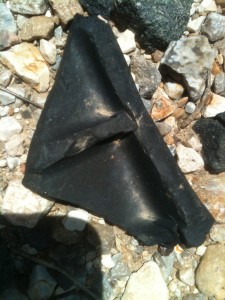 (FRISCO)—Three new documents, including two reports paid for by the City of Frisco but never publicly released, confirm that the former Exide lead smelter is the source of battery chips and slag waste that line Stewart Creek from Frisco to Lake Lewisville, and concludes the smelter site remains a continuing source of contamination.
(FRISCO)—Three new documents, including two reports paid for by the City of Frisco but never publicly released, confirm that the former Exide lead smelter is the source of battery chips and slag waste that line Stewart Creek from Frisco to Lake Lewisville, and concludes the smelter site remains a continuing source of contamination.
Samples taken in 2011 by a City of Frisco contractor found that 71% of Creek sediment collected had elevated levels of lead, cadmium or arsenic. A “visual survey” done for the City of smelter waste just three months ago found at least 45 “hot spots” of battery chips or slag along the entire five-mile route of the Creek, from the western edge of the smelter site all the way to its mouth at Lake Lewisville. Last year a state environmental inspector warned in an e-mail that she was concerned about the smelter’s battery chips making their way “into Stewart Creek and flowing to Grand Park where a parent who is also a Frisco resident pulls one out of their child’s mouth.”
Local group Frisco Unleaded received the documents last week as part of an Open Records Act Request to the Texas Commission for Environmental Quality. Members say the contents prove the public is right to be concerned about the impact of the smelter site on the City’s ambitious new Grand Park development. “These reports show why any activity downstream of the smelter, including the enjoyment of the new Grand Park, will be impossible without a comprehensive clean-up of the entire Exide site. This problem isn't just going to go away or fix itself," stated Meghan Green.
Green also called for the EPA to step in and take over a clean up that until now, has been directed by the state and city. "It’s clear that the toxins at the smelter are being washed into Stewart Creek with each rainfall and are surfacing and will continue to surface along the whole length of the Creek, which happens to also be a tributary into Lake Lewisville. To add insult to injury, Lake Lewisville is a source of drinking water for Dallas. To say that I'm concerned is an understatement. It’s time for the EPA to get more aggressive about protecting public health from this site.”
Although the smelter ceased operation in 2012 and demolition has taken place to remove most of the structures from the central Frisco site, the land itself is the burial ground for tons of lead waste in the form of pieces of used lead-acid batteries broken up for their contents and the slag waste produced from the smelting process. Frisco has arranged to buy an outer ring of the smelter property, but the core part of the operation remains in the hands of Exide, now going through bankruptcy. It’s that core, as well as the property Frisco is buying, that’s the source of the battery chips and slag migrating to Stewart Creek, which runs right though the middle of the Exide site.
That continuing threat to Stewart Creek, along with an assessment of historical contamination, is extensively chronicled in the City and State documents released by Frisco Unleaded today. They include:
1. A November 2011 “Limited Site Investigation” Of Stewart Creek by the City of Frisco
The City of Frisco specifically requested this investigation “to evaluate chemicals of concern in sediment in the vicinity of the Grand Park project.” Samples of sediment were collected at a total of 30 sites, and tested for Lead, Arsenic, Cadmium, Selenium, and Sulfates. 71% of the sediment samples tested for Lead, Cadmium and Arsenic exceeded the Texas Commission on Environmental Quality Ecological Benchmark.
2. March-April 2013, of Stewart Creek, Interim Report, City of Frisco
A year and a half after the Creek sediment sampling, contractors for the City of Frisco performed “a walking survey to identify and document the potential presence of visible battery chips and slag in Stewart Creek."
Chips and/or slag were observed in at least 45 different spots along the entire five-mile route of Stewart Creek from the smelter site in Frisco to the entrance of the Creek into Lake Lewisville, or an average of every 600 feet. The first sample was found at the mouth of the Creek as it flows into Lake Lewisville, a source of drinking water for the City of Dallas.
At least 29 hot spots of battery chips and/or slag were found within the boundaries of Grand Park, from Stonebrook Parkway on the south to the North Dallas Tollway, more than 4 times the number of any other segment along the survey. “Frequent occurrences of concentrated battery chips and potential slag material were observed in the Stewart Creek channel in Grand Park from Stonebrook Parkway to the Dallas North Tollway bridge.”
A Smelter Runs Thru It-Summary
3. TCEQ_battery_chip_emails from Texas Commission On Environmental Quality Staff on Recurring Battery Chip Contamination
In June of last year a TCEQ inspector wrote her supervisors that new concentrations of battery chips had shown up in previously clean-up areas of the smelter site. “These battery chips were believed to have washed up this year and accumulated down gradient along the tree line. Some of these chips were observed making their way down towards Stewart Creek. It looks like they’re being carried toward the trees and the creek with the rainwater. (Exide and City representatives) stated that the area was tested (prior to this new accumulation of battery chips) and it was below 250 ppm. I pointed out that there also wasn’t as many battery chips in those areas when the APAR was submitted. In the report, it states that the area would be covered with the geomembrane fabric and it sounded like this is what they want to do with these new battery chips as well (cover them with fabric). I pointed out that if I were to collect a sample that it would most likely exceed 250 ppm and there were just too many that had accumulated to be covered up with the fabric. As we all know, these chips move under rainy conditions. I told (the City representative) that our concern and I’m sure the city’s concern as well is if these battery chips made it into Stewart Creek and flowed to Grand Park where a parent who is also a Frisco resident pulls one out of their child’s mouth.”
One of her supervisors responds that chips will always come up with a rain: “Based on my experience from working on site contaminated with battery chips and slag, rubber battery chips that are buried will float to the surface (just tires in landfills). While working on sites associated with the West Dallas RSR lead smelter, with the exception of where chips were used as road based, every site that had surface chips on the surface were located over areas where slag and battery chips have been deposited in the past. Were subsurface investigations conducted in the areas of concern to determine the extent of contamination? Or did they only conduct surface investigations.”
Critics of the City’s approach to the smelter site clean-up cited the e-mail as a stunning example of Frisco’s caviler attitude about the contamination problem posed by the Creek. “We’ve often said the City is trying to figuratively cover-up the problem of Stewart Creek, but here’s an example of where they’re doing it literally,” said Jim Schermbeck of Downwinders at Risk, the regional clean air group assisting Frisco Unleaded.
Along with the City and State documents, Frisco Unleaded released the results of its own small sampling of battery chips members collected only last week from the public Right-of-Way on the BNSF railroad tracks leading into the smelter site. One of the chips had over 100 ppm of lead on it and 8.5 ppm of Arsenic. The Lead level is above the TCEQ Ecological Benchmark and the Arsenic level is just below it. Schermbeck said it was easy to collect the chips because they’re lying on the open ground.
Besides demanding that the EPA issue a “Imminent and Substantial Endangerment” order to begin addressing the Creek’s clean up, Frisco Unleaded and Downwinders called for the City of Frisco to release all of its Exide-related documents to the public and for the City of Dallas to begin interceding on behalf of its residents, whose drinking water is under threat from the smelter waste.
Green said that despite the City’s rhetorical promise to its residents to be transparent with them about the site, “that obviously hasn’t been the case since we had to get these city documents from the state. We deserve all the information the City Manager and Mayor have about this site. It’s our families, it’s our town, and it’s our tax money. The Mayor and Council need to make a commitment to residents that they’ll share everything they have about the site with the public. ”
Addressing the issue that could pull in Dallas and other cities, Schermbeck noted, “There’s now clear evidence that the Exide smelter has been a constant source of toxic contamination in Lake Lewisville for decades. The City of Dallas needs to wake-up and begin to lobby for the kind of environmental clean up that can put a stop to that contamination to its water supply.”
According to Schermbeck, it’s the new-found evidence of a continuing threat to the Creek and Lake that make this more than just another effort to clean up a past environmental mess, and warrants a serious escalation of regulatory responses. He noted that most toxicologists agree that there is no safe level of exposure to lead, especially for children, whose minds and bodies are still developing. “And yet, here’s this property on Creek’s edge, that’s proven to be a fountain of constant lead contamination flowing downstream through the middle of densely populated neighborhoods, and ending up in a source of municipal drinking water. It’s a clear and present danger to public health that deserves an immediate and potent remedy.”
+++++++++++++++++++
If you want to let Mayor Maso and the Frisco City Council know how you feel about their sitting on this inforamtion for almost two years, please send a qucik "Click N Send" e-mail to them via our "Featured Citizen Action of the Week." Thanks.
Why Exide Going Bankrupt Could Be a Good Thing
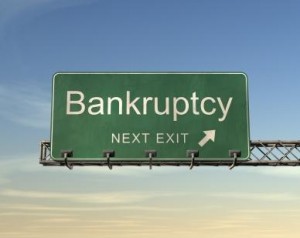 A months-long deathwatch surrounding Exide Technologies got a little closer to its climax on Thursday with a Wall Street Journal story quoting "people familiar with the matter" as saying the company was preparing to file for bankruptcy for a second time in a decade sometime this summer.
A months-long deathwatch surrounding Exide Technologies got a little closer to its climax on Thursday with a Wall Street Journal story quoting "people familiar with the matter" as saying the company was preparing to file for bankruptcy for a second time in a decade sometime this summer.
The original article is behind the Journal's pay wall, but it provides some details as to how the mechanics of such move would work. For one thing, the company's European operations won't be affected at all, according to the story. That's a hint that the company wants to find a way to fully separate its substantial US environmental liabilities – including the toxic waste dump formally known as the Frisco lead smelter – from what it considers to be its more salvageable parts.
Exide is carrying approximately $700 million in debt and many financial analysts doubt its ability to repay a $56 million note due in September. Thus, the summer timing. There was also probably some consideration to cash out while there was still some cash left. Shares of he company were selling for a record low of 34 cents on Thursday. It's last quarterly report in December 2012 cited a $15.4 million loss compared to a profit of $68 million in 2011.
Meanwhile, the company is providing plenty of work for lawyers and bankers:
Restructuring lawyers at Skadden, Arps, Slate, Meagher & Flom LLP are working with the company, while law firm Akin Gump Strauss Hauer & Feld LLP is advising an independent board committee, the people said. Paul, Weiss, Rifkind, Wharton & Garrison LLP is working with some bondholders and Andrews Kurth LLP is working with convertible-note holders, these people said.
Turnaround firm Alvarez & Marsal is working with the company, investment bank Houlihan Lokey is working with some bondholders and Moelis & Co. is working with convertible-note holders, they added.
Even money that the company has already spent more on this effort than they have cleaning up their mess in Frisco.
While completely predictable, this development now puts the City of Frisco at a crossroads for which it's not prepared.
Exide had no intention of rehabilitating or cleaning-up its Frisco smelter site – the part that still has decades and tons of lead contaminated waste buried in the ground – to provide for normal redevelopment. Even assuming the company and City are completely successful in cleaning up the outer zone of smelter property that the City is buying, there's no such plans for the 100 acres or more of hardcore toxic smelter property that was the core of the operations – and which has Stewart Creek running through it. The same Stewart Creek that runs from Exide into the proposed Grand Park. No matter how much the City tried to put a pretty bow on this situation, it still left a big toxic turd floating in the punchbowl, for which there was no contingency plans.
The upside of an Exide bankruptcy is that now the company won't be able to hold the rest of the City hostage by keeping the site a toxic dump forever. Because it won't own it anymore. Going belly up means there are other options besides the ones Exide was dictating because of its ownership.
On the other hand, bankruptcy for a company such as Exide usually means its environmental liabilities are absorbed by the taxpayers via the federal Superfund Site list. Exide already owns an abandoned local lead smelter. Dixie Smelter in South Dallas closed in 1990 as a result of the city's crack down on inner city lead smelters. It's been a fenced-off no man's land ever since. This is what Frisco city officials dread now. Once it's listed for clean-up it may take decades for it to actually happen. The result is the same as if Exide never lost ownership – you still have a toxic waste dump with the Creek running through it on the way to your new regional park.
What to do? The big difference between this lead smelter site and the ones in Dallas is location. Although originally sited on "the other side of the tracks" in Frisco, the city has transformed itself into the North Texas suburb of choice, to the point where the smelter property is now surrounded by exclusive gated communities and malls.
The City should use this fact, and this brief moment before actual bankruptcy, to work with Exide, the EPA, private developers who specialize in reclaiming contaminated sites, and local banks to formalize a plan to completely clean up the entire Exide smelter site in return for being able to build a signature project that will connect Grand Park to Downtown Frisco. Imagine if the smelter and its waste wasn't there on the property – immediately on the North Dallas Tollroad, with a creek running through it, connected to the city's signature green space. It would be another Los Colinas.
The problem, and its a huge one, is to assemble the considerable money it would take to clean the property, while also raising the money it would take to actually build the project, and assume liability for whatever surprises might be found on site in the future. Frisco could do its part by giving generous tax breaks to the developers. EPA could do its part by easing regulatory requirements for transfer. Exide could do its part by selling the land to the City for $1 so that Frisco could concentrate its resources on rehabilitation, not purchase price. There is now considerable self-interest to work a deal that wasn't there before the Exide bankruptcy.
The point is, Frisco officials must be able to answer the question: What's the ultimate plan for Exide property? To let it sit as a toxic waste dump? To let it sit as a toxic waste dump next to a new park that features the same creek that runs through the toxic waste dump? Or is there something more that can and should be done?
City Hall showed a great deal of creativity in drawing up the agreement that resulted in shutting Exide's outlaw smelter operation down. It now needs to exert the same creativity in coming up with a rescue plan for the property the smelter left behind.
Residents Push Back on Frisco Smelter Clean-Up Standards; Report Raises Questions About Huge New City Park Next to “Potential Superfund Site”
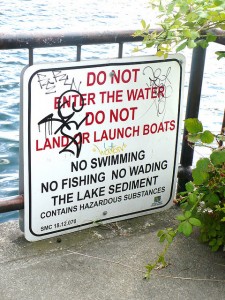 (Frisco)–Frisco residents directly challenged their city’s attempt to gloss over what they say is an important decision to use a less-protective testing method to find toxic contamination on the Exide smelter site, while also releasing a new report that chronicles how that contamination could disrupt plans to build the city’s ambitious “Grand Park.”
(Frisco)–Frisco residents directly challenged their city’s attempt to gloss over what they say is an important decision to use a less-protective testing method to find toxic contamination on the Exide smelter site, while also releasing a new report that chronicles how that contamination could disrupt plans to build the city’s ambitious “Grand Park.”
Saying city officials either don’t know what method is actually being used for finding “hot spots” of contamination, or isn’t being truthful about its use, members of Frisco Unleaded contrasted an official city denial from Assistant City Manager Ron Patterson with a March memo from the Texas Commission on Environmental Quality.
“Although you state in your response….“an industrial sampling protocol is not being used on the J Parcel,” you are incorrect,” says a letter sent by the group to Patterson and the Frisco City Council on Monday. “Please refer to the Texas Commission on Environmental Quality memo, dated March 8th of this year, accompanying our May 28th letter….TCEQ’s Danielle Lesikar clearly states that the 2 samples per acre testing method, “is a Commercial Industrial Standard,” and “only meets (the) Commercial-Industrial” standards. We’d appreciate if you’d forward documentation that disproves this statement….”
Members of the group say the difference is small but critical. Instead of eight soil samples per acre at the highly contaminated site, Exide is only sampling twice per acre, and so far less likely to find all the toxic material that needs to be removed to bring down high levels of lead, cadmium and other potential contaminants after almost 50 years of smelter operation.
Making sure there are no toxic surprises is important for redevelopment of the site itself, as well as the construction and use of the City’s new 275-acre Grand Park, located only 500 feet away from the smelter property and directly downstream of the Exide contamination via Stewart Creek, which is key to the park’s chain of lakes and water features. That’s the subject of the group’s new report.
“Poisoned Park? How Exide’s Lead Contamination Risks Frisco’s Grand Park,” was released to coincide with the last of three public “design meetings” for Grand Park at City Hall on Monday afternoon. In it, Frisco Unleaded compiles the long litany of abuse to Stewart Creek and the surrounding land by the smelter recorded by state and federal inspectors, including lining the banks of the Creek with toxic lead slag waste, dumping lead waste directly into the Creek, and locating waste dumps and pits in its floodplains.
“This poor Creek has been more or less an open sewer for the entire Exide smelter property for decades. There’s every indication that a lot of contamination is still there. And yet city officials are pretending that they aren’t trying to build a huge park centered along the course of this same Creek, immediately next door, and upstream of the Smelter. None of the previous design meetings have even raised the possibility of an environmental assessment of the threat Exide’s contamination poses to the Park,” said Frisco Unleaded board member Meghan Green.
Besides chronicling the past and current threats to the creek and potential ones to the new Park, the report features the boundaries of Exide’s hazardous waster permit superimposed on FEMA 100-year floodplain maps and USGS topographical maps to indicate how much of Stewart Creek has been affected by the Smelter, which literally sits on either side of its banks before flowing west under the Dallas North Tollway into what would be the new Grand Park.
“It’s important to get the most protective clean-up of the Exide property that we can” said Frisco Unleaded Chair Colette McCadden, “because all of the run-off from the property will be headed directly into the Park and the City itself has proposed building an entire Stewart Creek green belt corridor that would follow the Creek into the Park. This isn’t an industrial site that is sitting in isolation from people and activity. This is a site that’s next to Frisco’s largest park.”
“With the financial condition of the company deteriorating,” added Downwinders at Risk Director Jim Schermbeck, “it’s very possible the smelter site could end up on the EPA’s federal Superfund Site list, and then you’d have the a toxic waste dump site as a neighbor to Frisco’s most ambitious park.”
Among problems for Grand Park development pointed out by the report:
- Despite inspection reports citing known and potential contamination affecting Stewart Creek, no remediation has been performed there in 13 years.
- There’s not sufficient protection from flooding at the site, despite most of the facility being located in low-lying, flood prone areas.
- The FEMA 100-year floodplain runs directly through a landfill full of Exide lead slag, within just 100 feet of a “waste pile” of contaminated dredging from Stewart Creek, and within 200 feet of lead landfills that are in various states of disrepair.
- There’s been no extensive testing of soil, sediment or water within the boundaries of the new park, or between the Smelter and the park, where new contamination has recently been discovered.
The report makes four specific recommendations to insure park and public safety:
- City Officials should commission a full environmental assessment of the Grand Park Project before project planning and development go any further.
- The clean-up of the Exide smelter site should be to the most protective “Residential” standards to allow for open spaces use along Stewart Creek.
- All landfills, dumps and pits of lead waste should be removed from the Exide site to prevent future contamination problems from occurring.
- The water quality of Stewart Creek must be assured.
Frisco Kids Play Within Feet of a Hazardous Waste Dump
This is a 23 second video shot on the corner of Eubanks and 5th Street in Frisco earlier this month. This corner is the northeast border for the property owned by the Exide lead smelter.
When it begins, the camera is looking south toward the now shuttered smelter. In fact, at the 3-second mark, you actualy see the smelter's smokestacks betwen two trees for a brief moment. In front of those trees is the fenceline separating the smelter property from the public. Immediately behind those trees is a berm that marks where the smelter's active landfill is.
This "non-hazardous" landfill holds approximately 9 million pounds of lead-contaminated waste. Lead itself is dangerous, but Exide got caught illegally burying hazarous waste in this non-hazardous landfill. The company's remedy is to dig the hazardous waste up, "re-treat it" and then re-bury it in exactly the same landfill. All this is to be done at the edge of the smelter's property at this corner of Eubanks and 5th.
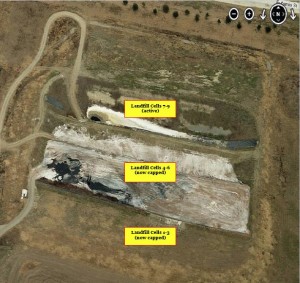
This is an aerial pic of the Exide active landfill operation at the corner of Eubanks and 5th Street. The line of the trees at the top right are the same ones you see in the video.
Besides this waste from production, Exide is now using the landfill to dispose of as much smelter demolition waste as possible. That makes it the most active spot on the smelter property at this point, with trucks full of waste coming and going besides the on-going "digging and "re-treatment" there.
And when Exide is finished stuffing all the lead-contaminated waste it can into this landfill, it hopes to leave it buried in Frisco forever.
Directly across the street from this illegal hazardous waste landfill is the "Play Ball" rec center for kids – a batting cage business. On nice days, you can usually find the south-facing/smelter-facing metal garage door wide open to allow for air circulation for the kids taking practice inside.You can also find their sibings and peers playing on the front driveway, only about 50-100 feet away from the lip of that landfill berm.
When the wind is out of the south, as it often is from March to October, the Play Ball batting cages and the kids there are are directly downwind of the smelter and the landfill operation. A lead-in-air monitor operated by the the Texas Commission on Environmental Quality is located on Eubanks. It's that skinny white pole in the middle of the frame at the 5-second mark. This monitor has repeatedly found concentrations of lead in the air higher than the EPA's new national lead in air standard – since the smelter closed.
So not only are these kids subject to being downwind of all of the smelter's demolition activity. They're also just across the street from the most heavily used part of the smelter now, with a much larger risk of getting contaminated.
Exide, the City of Frisco and the Texas Commission on Environmental Quality all would have you believe that everything is hunky-dory at the lead-smelter site. Look, the smokestacks are coming down! But in reality, this site is still posing risks for Frisco children who are still playing right across the street.
Latest Stop in Slo-Mo Exide Train Wreck: Thursday 5-7pm
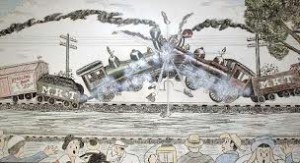 Coming down the hill from the west is a freight train full of woe for Exide. It's carrying at least five shareholder lawsuits aimed at the company for not disclosing its environmental liabilities, including those stemming from the operation of its Vernon, California smelter. That would be the same smelter California state officials shut down due to leaking lead waste and an unacceptable cancer risk to over 100,000 local residents. On board is a "restructuring specialist" who is supposed to see the company through its second bankruptcy in a decade. As of last week, Exide stock was selling for a cool 75 cents a share. The whole company is about to shoot off the rails.
Coming down the hill from the west is a freight train full of woe for Exide. It's carrying at least five shareholder lawsuits aimed at the company for not disclosing its environmental liabilities, including those stemming from the operation of its Vernon, California smelter. That would be the same smelter California state officials shut down due to leaking lead waste and an unacceptable cancer risk to over 100,000 local residents. On board is a "restructuring specialist" who is supposed to see the company through its second bankruptcy in a decade. As of last week, Exide stock was selling for a cool 75 cents a share. The whole company is about to shoot off the rails.
Meeting it head-on coming from the east is the Exide's smelter site in Frisco, over 100 acres and fifty years of sloppy handling and disposal of hazardous lead, arsenic, cadmium, dioxin and other poisons. There are "pre-RCRA" sites aplenty – meaning they were there before any regulations could catch up with them, as well as more recent disasters like the illegal burying of hazardous waste in a non-hazardous landfill. Just last week the City of Frisco released a preliminary environmental assessment of the LEAST-contaminated parts of the smelter that revealed new potential contamination as well as the fact that the entirety of Stewart Creek had been re-routed around the smelter in 1964 – leaving the original channel underneath the MOST contaminated part of the smelter. Moreover, even though the smelter closed in November of last year, it's been routinely causing high levels of lead air pollution from the demolition and closure operations going on.
Caught in the middle are Frisco residents who just want to live without a lot of lead in their air for awhile, and don't want to see a new Superfund Site in their town. The state's Texas Commission in Environmental Quality is in its usual "Yes Man" role to industry and seemingly finds no fault in any of Exide's plans to leave pits and landfills full of smelter waste in Frisco permanently. Having made its sweetheart deal to close the smelter, the City of Frisco has taken a back seat to the company and TCEQ when it's come time to figure out how best to clean-up the site.
Thursday night Exide is sponsoring another one of its "community meetings" in which the community is invited to come hear company representatives put nice spin on everything as well as duck questions about its financial responsibilities and long-term plans. It's no substitute for a real public meeting but its the only game in town for Frisco residents who don't want to see a toxic waste dump site remain downtown.
Exide Community Meeting 5 to 7 pm Frisco Depot 6321 Paige Street – behind Babe's.
We Hate to Say We Told You So, But….
 California Public Radio reports...
California Public Radio reports...
The California Department of Toxic Substances Control has shut down a battery recycling plant in Vernon whose own investigation revealed that it’s contaminating the soil around it. Exide Technologies recycles 22 million car batteries a year at its Vernon plant. The DTSC said Wednesday that it has suspended Exide’s operating permit.
Last month, regional air regulators said arsenic in Exide’s emissions has raised cancer risks for people in nearby Maywood, Huntington Park and Boyle Heights. DTSC Director Debbie Raphael says video provided by Exide shows that its wastewater pipes are leaking metals and other toxic substances into the ground.
The consumer advocacy group Consumer Watchdog said the DTSC “did the right thing” in suspending Exide’s operating permit, but the group also criticized the agency for never forcing the company to comply with laws that required it to prove it had enough cash to pay for any actions required by regulators, including the cost of closure.
“Exide has only put up $10 million dollars for closure—that is nowhere near enough” if the company needs to clean up a high level of toxic contamination, said Consumer Watchdog’s Liza Tucker. In that case, “Californians could be left holding the bag,” she said.
It'a all relative. Right now, Frisco residents wouldn't even have the bag. The town is putting its fate in the hands of a company that's finding new ways to circle the drain for the second time in a decade. While Exide and the regulatory agencies may want to pretend the California crisis has nothing to do with the company's ability to carry out a first-class demolition and closure at its Frisco smelter site, common sense says otherwise. Frisco needs an exit strategy.
Why Frisco’s Lead Clean-up is Now Tied to California Courts
 Smelling green, lawyers suing on behalf of Exide shareholders have begun to flock to the Golden Gate state's courts to file lawsuits alleging the company lied to purchasers of stock about the substantial environmental liability of the company's Vernon smelter, recently cited as presenting the highest cancer risk of any industrial facility in Southern California.
Smelling green, lawyers suing on behalf of Exide shareholders have begun to flock to the Golden Gate state's courts to file lawsuits alleging the company lied to purchasers of stock about the substantial environmental liability of the company's Vernon smelter, recently cited as presenting the highest cancer risk of any industrial facility in Southern California.
At last count there were at least five separate law firms preparing to sue, alleging Exide has…
"…violated certain provisions of the Securities Exchange Act of 1934. Specifically, the complaint alleges that defendants misrepresented and/or failed to disclose that, among other things: (a) the Company was polluting the environment and exposing almost 110,000 residents near its Vernon, California battery recycling facility with potentially fatal levels of arsenic and other pollutants; (b) the Company knew that it would not be able to meet its debt repayment obligations and other pledges and promises based on actual and projected revenues and expenses; and (c) the Company knew that its environmental liabilities, debt obligations and potential insolvency did not support Exide’s statements to investors. According to this complaint, when these facts were finally revealed to the market, Exide’s shares plummeted by approximately 46%.
This isn't the first, or even the second or third time the company has had these kinds of problems. As it turns out, Exide has a history of financial shakiness and corporate irresponsibility:
Despite market dominance, Exide lost about 75% of its share value from 1996 to 1998. Some shareholders sued management, alleging misrepresentation, and the Florida attorney general and the SEC launched probes into whether the company sold used batteries as new. (In 1999 Exide settled with Florida without admitting wrongdoing, and it also settled with shareholders.) In 1998 management clumsily announced a recapitalization attempt and then changed its mind. Amid these problems, Hawkins resigned as chairman and CEO and former Chrysler exec Robert Lutz replaced him.
In 1999 Exide canceled a contract with Sears (4 million batteries a year) to focus on profits rather than volume. Later that year Exide sold its Speedclip division to Prestolite Wire. In 2000 it acquired the global battery business of Pacific Dunlop (now Ansell Limited), GNB Technologies. Exide also sold its remanufactured starter and alternator business (Sure Start).
In 2001 Exide agreed to a plea deal with federal prosecutors whereby the company would pay out $27.5 million in fines over five years. The company admitted to making defective batteries, covering up the defects, and bribing a Sears, Roebuck buyer. Burdened with heavy debt, Exide also announced in 2001 that it planned to issue 20 million new shares in a debt-for-equity deal. That year the company changed its name from Exide Corporation to Exide Technologies.
In 2002 Exide filed for Chapter 11 bankruptcy reorganization as a result of its acquisitions bender and poor conditions in the automotive sector. Later in the year Exide inked a deal to become the exclusive battery supplier to Volvo Truck Australia, giving the battery maker a 74% market share for heavy truck batteries in Australia.
Arthur Hawkins, the former CEO of Exide, was convicted in 2002 of fraudulently selling defective batteries to Sears Automotive Marketing Services. He was sentenced to 10 years in federal prison; the sentence was upheld in 2005. Three other Exide executives were convicted of various federal charges.
When Exide emerged from Chapter 11 bankruptcy in 2004, the company had cut its debt by a reported 70%. That year the company combined its motive power and network power operations into one segment, industrial energy.
While Exide exited Chapter 11, it still experienced corporate pain — the company continued to lose money, and it shut down its lead-acid battery manufacturing plant in Shreveport, Louisiana, in 2006. The plant served Ford Motor and other aftermarket customers. The Shreveport factory was operating since 1968. Production was shifted to other Exide facilities.
Guess what lucky North Texas community helped pick up Exide's slack?
So this is the corporate entity the City of Frisco reached an agreement with concerning the "outer ring" of the Exide lead smelter in that town, also other wise known as the "J" parcel. As it turns out, that agreement gives the company a big financial incentive to clean up that part of their property and hand it over to the City for development. Exide is counting on getting $45 million from the City when the clean-up of the "J Parcel is given the Good Housekeeping Seal. To put that amount in perspective, 2013 second quarter operating income for Exide was only $6.8 million.
So if Exide is as greedy and needy as their record indicates, that J Parcel will be spic and span. But that's not the land the smelter and all of Exide's tons of lead smelter waste is on. That's on the approximately 100 acres smack dab in the middle of the J Parcel and central Frisco that Exide will still own. And there's no City deal to make sure that contaminated property is ever cleaned up.
Now add the current round of financial troubles Exide is in and there's absolutely no incentive for the company to spend money on the kind of state-of-the-art clean-up Frisco residents say they want. In fact there's a huge disincentive. Frisco is a former Exide smelter site with no discernable assets and all sorts of long-term expensive liabilities. And if Exide goes belly-up, the City will find itself at the end of a long line of creditors, beginning with the shareholders who have the best lawyers, with little luck in recovering the money necessary to do a proper cleaning and closure.
The solution? Perhaps a little pro-active planning on Frisco's part could make sure the money is there to clean-up the worst of the worst contamination in a timely way. Requiring Exide to put up a bond pre-bankruptcy, or maybe taxing hazardous waste disposal by the pound are two possible paths that come to mind. Unless the City does something like this, and soon, it's central downtown development, and ambitious Grand Park plans will be forever held hostage to the fate of a company that's looking less and less viable with each passing day.
UPDATE: It was announced Wednesday that the State of California has ordered the Vernon smelter closed because the facility has "been continuously releasing hazardous waste into the soil beneath its plant because of a degraded pipeline" along with poisoning an unacceptable cancer risks.
Exide’s Crappy California Smelter Raising Cancer Risks
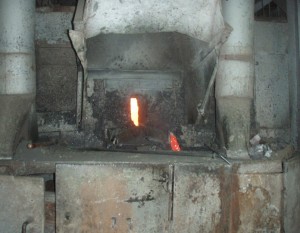 We've linked to the sad and horrible stories coming from ex-employees of the Frisco Exide Lead smelter that paint a disturbing picture of what went on when the public and regulators weren't looking. But this is Texas, where you practially have to have dead bodies piled up along your fenceline to get the state to do much about polluters and their pollution. What might happen if Exide were to have a rogue smelter in less-polluter-hospitable place, like, say, California?
We've linked to the sad and horrible stories coming from ex-employees of the Frisco Exide Lead smelter that paint a disturbing picture of what went on when the public and regulators weren't looking. But this is Texas, where you practially have to have dead bodies piled up along your fenceline to get the state to do much about polluters and their pollution. What might happen if Exide were to have a rogue smelter in less-polluter-hospitable place, like, say, California?
A battery recycling plant in Vernon is being told to reduce its emissions after recent tests showed it is posing a danger to as many as 110,000 people living in an area that extends from Boyle Heights to Maywood and Huntington Park.
The South Coast Air Quality Management District announced late Friday that Exide Technologies, one of the largest battery recyclers in the world, must also hold public meetings later this spring to inform residents that they face an increased cancer risk and outline steps being taken to reduce it.
Air district officials said Exide's most recent assessment showed a higher cancer risk affecting a larger number of residents than any other of the more than 450 regulated facilities in Southern California over the 25-year history of a program to monitor toxic air contaminants. The primary contaminant in this case was arsenic.
There has been "nothing close to this … never," said Sam Atwood, spokesman for the air district.In a statement, Exide officials said they planned to work with the district on emissions reductions "that we expect will meet or exceed" requirements. "Exide takes its environmental responsibilities seriously…."
Yes, so seriously, they've waited until they got caught to address these arsenic emissions. According to the most recent estimates, the company is posing a risk of 156 cancers per million population. The EPA standard is one in a million.
Under California's regulations, when cancer risk from a facility reaches 10 per million, public notification is required. When it hits 25, facilities must take steps to reduce their emissions. Exide was six times over that limit.
Since the 1987 Toxic Hot Spots program went into effect, only about 20 facilities in Southern California have ever reported risks that were greater than 25 in 1 million. More than 95% of the facilities the air district regulates have risks under 10 in 1 million.
California will force Exide to produce a "Risk Reduction Plan" within 6 months that will have to outline how the company will reduce its arsenic emissions. Failure to do so could result in $25,000 a day fines and a shut down order from a judge.
Meanwhile, Exide is doing everything possible in Frisco to make sure that city will have lead-waste landfills along Stewart Creek and near downtown forever – refusing to remove the hazardous waste that's been found in them in favor of "treating" it in place in town and saying it wants to "cap" all the dumps and landfills, even though many are on slopes and one is even partially in the flood plain.
Our bet is that Exide will choose to close its California smelter rather than install state-of-the-art controls, and then Frisco will have yet another community to commiserate with over the company's toxic leftovers.
Science Outpacing EPA Lead Contamination Standards
 People who don't know any better expect agencies that are charged with removing environmental threats to public health to be on top of the best and most recent science. However, because of the glacial pace of government environmental oversight, that's hardly ever true. It takes years, and sometimes decades for "safe standards" to be updated or created. When they are, they're sometimes instantly obsolete because a new generation of studies has shown harm at even lower levels of exposure. This is why impacted citizens have to have a DIY philosophy to seek out the most recent science themselves – you can't depend on government to have already incorporated it or be using it as a guide.
People who don't know any better expect agencies that are charged with removing environmental threats to public health to be on top of the best and most recent science. However, because of the glacial pace of government environmental oversight, that's hardly ever true. It takes years, and sometimes decades for "safe standards" to be updated or created. When they are, they're sometimes instantly obsolete because a new generation of studies has shown harm at even lower levels of exposure. This is why impacted citizens have to have a DIY philosophy to seek out the most recent science themselves – you can't depend on government to have already incorporated it or be using it as a guide.
A particularly depressing example is the way the US EPA is dealing with lead contamination and its soil and dust standards. The last time these were updated, Bill Clinton was President. There's been a lot of science produced on lead poisoning since then and all of it points to lower and lower levels of exposure causing harm. In fact, there's a consensus among researchers that there is NO safe level of exposure to lead. It's not that every exposure will harm you, it's that every exposure is capable of doing harm – especially to children.
There's also overwhelming public policy consensus that exposures to lead should be minimized as much as possible. Reducing exposure to lead is now linked, not just to better physical health, i.e. less cancer, liver disease, etc., but to higher IQs and test scores in schools, less anti-social behavior, and even less crime. In California, the lead standard for soil has been reduced to 80 parts per million, compared to the circa-2000 EPA standard still in place of 400 ppm.
Acting in recognition of these facts, for the first time in over 20 years the federal Centers for Disease Control revised its lead-in-blood standard for children in 2012, cutting in half the amount it said should trigger a response from parent and doctor. As a consequence, the EPA's own Children's Health Protection Advisory Committee sent a letter to then-Administrator Lisa Jackson calling for the agency's "immediate and urgent attention" to revise the nation's lead dust and soil standards because they had been based on the previous, now-obsolete CDC standard.
But in the latest installment of her year long award-winning series of articles on the topic, USA TODAY's Allison Young quotes EPA officials as saying they have no current plans to update those standards to reflect the new CDC lead in blood action level. This, despite studying the issue since 2009. What difference does it make?
In places like Frisco, Texas that experienced decades of lead contamination from a poorly and often illegally-operated lead smelter, it means the EPA will allow what it knows to be dangerous levels of lead to remain in soil and dust that otherwise would have to be cleaned-up.
This is Exhibit A why citizens cannot leave environmental protection to government agencies alone. This is why Frisco residents, organized by Frisco Unleaded, are trying to intervene directly in the closure and clean-up of the Exide lead smelter. If you leave it up to the state or EPA, you won't have the best science, or the most protective clean-up. You will have settled for whatever government standard was in place at the time, no matter how outdated or unsafe. If you're a parent in Frisco, that shouldn't be YOUR standard.
Former Exide Smelter Employee: It WAS as Crappy As You Thought
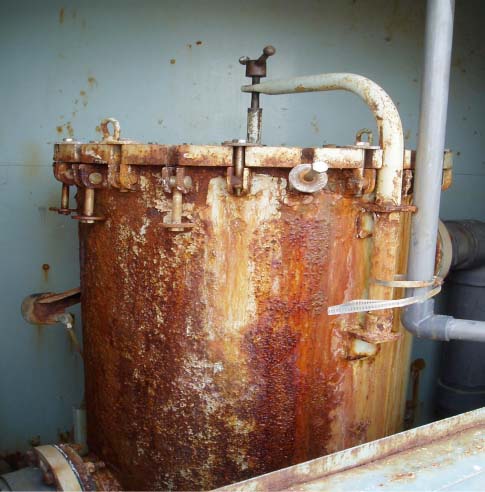 Although the Great Dallas Drilling Scandal has kept our heads spinning lately, we did mange to take note of a rather big story in a small paper that should get a lot more coverage.
Although the Great Dallas Drilling Scandal has kept our heads spinning lately, we did mange to take note of a rather big story in a small paper that should get a lot more coverage.
On February 21st, the Frisco Enterprise-Plano Star community newspaper published an article about the Exide lead smelter in Frisco using an unnamed ex-Exide employee as the sole source. The sole source's anonymity probably kept major outlets from offering the same coverage, but in this case the specifics are so compelling that we're glad the suburban chain took the chance.
Although he never gives his name, the Star says the employee "served in a managerial position at the plant." From the workday scenarios he describes he appears to have been directly involved in Exide's production line. Taken together, all of the accounts he gives the paper would seem to confirm residents' impression that the circa- mid 1960's Frisco facility was a mobile home park with a lead smelter in the middle of it.
"I guess we were probably producing $200,000 worth of product every shift — $600,000 worth of product every day," he said. "Yet [one time] we had six people working on [maintenance when the plant lost power]. We had one flashlight and one set of tools. What I needed was six flashlights and six sets of tools, but they wouldn't even give me that."
If Exide wouldn't open up the corporate wallet for flashlights, no wonder the company balked for so long about adding multi-million pollution controls to reduce lead emissions to legal levels.
And, according to the Star's source, those lead (and cadmium and arsenic) emissions could be many times what's been officially estimated by government agencies, or even citizens' own air modeling results published last year.
Power being knocked out was a particular issue, the source said, as vapors resulting from the lead-acid recycling system were no longer captured. Those vapors include lead particles, and long periods of lead exposure result in chronic lead poisoning, which in turn can result in physical defects such as kidney damage.
The former employee doesn't say how often this kind of outage occurred, but he makes it clear it wasn't infrequent. It wouldn't take too many such incidents to significantly raise the exposure level of those residents living downwind. Of course, when the state and EPA are calculating what constitutes "safe" levels of exposure to a facility's pollution, they never take into account these kind of "upsets" or accidents that can balloon the chances of inhaling harmful poisons.
Among the other allegations made by the ex-employee:
Only 1/5 of the violations Exide received "for a lack of federal compliance or unsafe working conditions" were forwarded to the Texas Commission on Environmental Quality.
Incident reports submitted to the state about violations represented "a great difference in the truth" between what was being claimed by Exide, and what really happened.
These incidents were as frequent as every other week.
Prior to the announced visits of TCEQ or EPA inspectors, "employees were paid overtime to clean the plant extensively. The same initiative was made before visits by non-plant employees, such as trips by corporate managers. Outside of those events, however, the plant was rarely cleaned."
Carbon dioxide monitors were constantly beeping, indicating dangerous CO2 levels. "The environment of operations was poisoning us."
Ah, but all of that is in the past, right? Not with Exide planning to leave over 9 million pounds of lead smelter waste behind on 90 acres in the middle of central Frisco, with another hundred acres or so outside of that donut hole" being purchased by the city for rehabilitation.
When asked if he would feel comfortable visiting the land Frisco purchased from Exide when it's remediated to federally compliant levels, the former employee said he wouldn't.
"With the way it's going right now, I'll never take my children or my dog to that area," he said. "I studied petroleum engineering and geology in college, and I know the bad stuff sinks to the bottom. I will never [go there]. It'll be nice to have it gone, but I don't know how you patch that up. You have to pull up everything, wrap it up and get it gone."
Official reaction was predictable:
"An Exide Technologies spokeswoman said the company "does not comment on unsubstantiated hearsay"…"A TCEQ spokeswoman said she could not comment on whether or not an employee signing an incident report with false information would be illegal without being told what reports are in question."
It'd be better if former employees like this came completely forward and were willing to cooperate with the EPA in exchange for immunity, but we're grateful for the peak inside Exide. It confirms not only what we already suspected about the way this company and this plant did business, it also once again confirms the way all bad acting polluters behave when it comes to hiding their real identity from the public and regulators.
